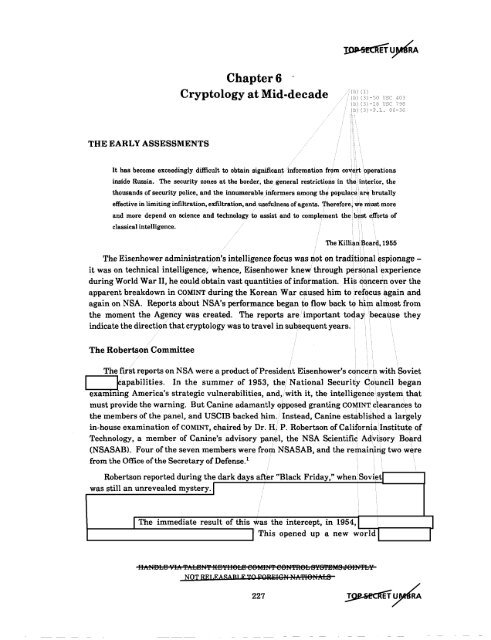American Cryptology during the Cold War - The Black Vault
American Cryptology during the Cold War - The Black Vault
American Cryptology during the Cold War - The Black Vault
You also want an ePaper? Increase the reach of your titles
YUMPU automatically turns print PDFs into web optimized ePapers that Google loves.
Chapter 6<br />
<strong>Cryptology</strong> at Mid-decade<br />
Ib) (1)<br />
Ib) (3) -50 USC 403<br />
Ib) (3) -18 USC 798<br />
Ib) (3) -P.L. 86-36<br />
THE EARLY ASSESSMENTS<br />
It has become exceedingly difficult to obtain significantinformation from coV'ettoperations<br />
inside Russia.<br />
<strong>The</strong> security zones at <strong>the</strong> border, <strong>the</strong> general restrictions in <strong>the</strong> interior, <strong>the</strong><br />
thousands of security police, and <strong>the</strong> innumerable.informers among <strong>the</strong> populace.are brutally<br />
effective in limiting infiltration, exfiltration, and usefulness ofagents. <strong>The</strong>refore, we must more<br />
and more depend on science and technology to assist and to complement <strong>the</strong>·. best efforts of<br />
classical intelligence.<br />
<strong>The</strong> KillianBoard,1955<br />
<strong>The</strong> Eisenhower administration's intelligence focus was not on traditiOnal espionage <br />
it was on technical intelligence, whence, Eisenhower knew through personal experience<br />
<strong>during</strong> World <strong>War</strong> II, he couldobtain vast quantities of information. His concern over <strong>the</strong><br />
apparent breakdown in COMINT <strong>during</strong> <strong>the</strong> Korean <strong>War</strong> caused him to refocus again and<br />
again on NSA. Reportsabout NSA's performance began to flow back to hUn almost from<br />
<strong>the</strong> moment <strong>the</strong> Agency was created. <strong>The</strong> reports are important toclaybeca1.l.se <strong>the</strong>y<br />
indicate <strong>the</strong> direction that cryptology was to travel in subsequent years.<br />
<strong>The</strong> Robertson Committee<br />
<strong>The</strong> first reports on NSA were a product ofPresident Eisenhower's concern with Soviet<br />
I-----.,fapabilities. In <strong>the</strong> summer of 1953, <strong>the</strong> National Security Council began<br />
examining America's strategic vulnerabilities, and,with it, <strong>the</strong> intelligence system that<br />
must provide <strong>the</strong> warning. But Canine adamantly opposed granting COMINT. clearances to<br />
<strong>the</strong> members of <strong>the</strong> panel, and USCIB backed him. Instead, Canine established a largely<br />
in-house examination of COMINT, chaired by Dr. H.. P. Robertson ofCaliforniaInstitute of<br />
Technology, a member of Canine's advisory panel, <strong>the</strong> NSA Scientific Advisory Board<br />
(NSASAB). Four of <strong>the</strong> seven members were from NSASAB, and <strong>the</strong> remaining two were<br />
from <strong>the</strong> Office of<strong>the</strong> Secretary of Defense. 1<br />
Robertson reported <strong>during</strong> <strong>the</strong> dark days after "<strong>Black</strong> Friday," whenSovi.etl<br />
was still an unrevealed mystery. I<br />
I<br />
I <strong>The</strong> immediate result of this was <strong>the</strong> intercept, in 1954,<br />
f This opened up a new world<br />
I<br />
I<br />
UA:NBbEl VIA 'f¥tLElN'f !ESYII6LEl e8MIH'f e8N'fR8J:: S"l"S'ffJMS 48H,'fJ::Y<br />
NOT REJ.EASABI E 1'0 ~QRi:I~H'fmr'fI8N:ALS<br />
227
















